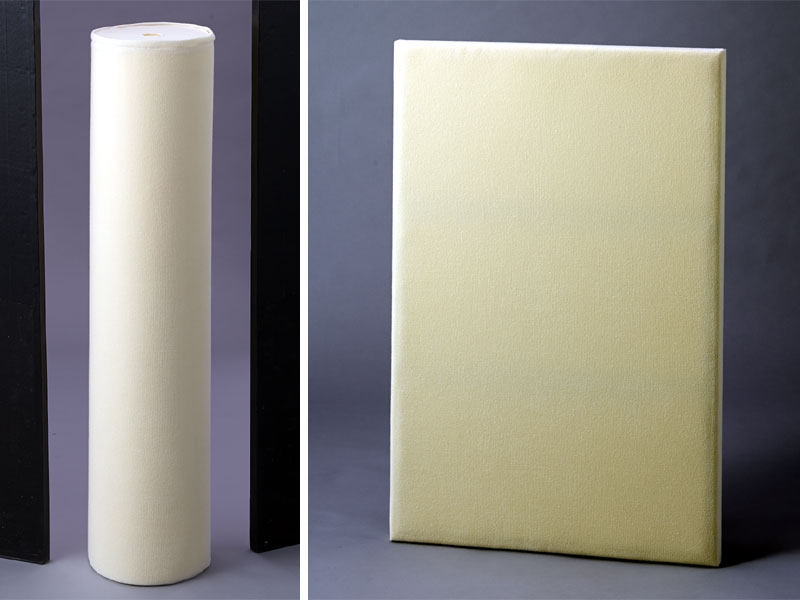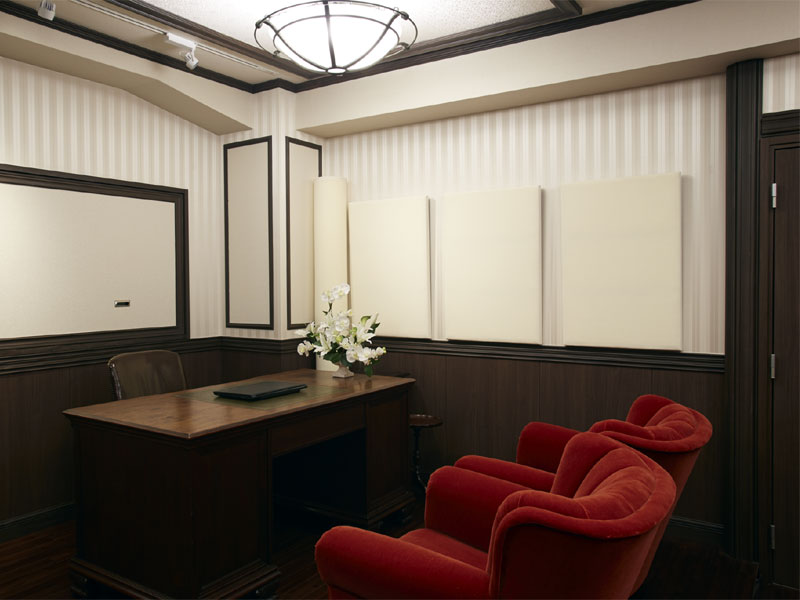First Sounds: Zanden Audio AP-1 and AT-2
While these attributes (clarity and control) are desirable for home audio, I have been unconvinced by many attempts to maximize them at home with acoustic treatments. In my experience, the introduction of acoustic treatments makes the listening room sound different but not necessarily better, and occasionally makes the room sound much worse. I’m not embarrassed to mention that my favorite listening space is at a friend’s house. He uses two fake ficus trees behind the speakers for acoustic treatment. I fully acknowledge that every room needs addressing, but my experiences have made me leery of doing so to my own room.
So when Eric Pheils of Zanden Audio USA offered to install eight Zanden AP-1 panels (above right, $350 each) and two AT-2 tubes (above left, $950 each) to treat my living room, I hoped that his eight-hour trip to rural Missouri wouldn’t be a waste of his time. The AP-1 is a flat panel covered in cloth; it measures roughly two feet wide and three feet tall, and an inch and half thick. Each panel has a wooden frame inside and small picture hangers on the back to allow for permanent installation on a wall. The AT-2 tube is 78" tall and 8" in diameter. A center hole in either end accommodates the optional AP-1 stand ($160). Touching both products will remind you of very soft memory foam. The samples were a deep black, while other choices are a cream color and gray. What makes the Zanden panels and tubes different than those already available is the foam material inside, which is called Crie-Composite. It was developed by Naraji Sakamoto, head of Panasonic’s Audio Research Center and the man who is credited for the Technics brand name. His work as an acoustic engineer led him to discover a polyurethane foam that combines the attenuating properties of Fiberglas with ideal damping properties unavailable in ordinary polyurethane foams. Zanden’s work with this material was covered by Japanese audio journals, prompting Mitsubishi Electric to use Crie-Composite exclusively in constructing its own anechoic chamber. Neither Eric nor I wanted to attach the panels to my walls permanently, so he brought along a skeletal frame made of PVC pipe. This allowed him to attach the panels’ hangers to the frame with zip ties. The resulting temporary wall of eight AP-1 panels measured six feet tall and eight feet wide, standing about one foot out from the wall behind it. It was centered behind my audio racks. I thought this was unusual, as conventional wisdom says to place your treatments at first-reflection points. The tall AT-2 tubes were placed to the outside of the AP-1 panels and against the wall behind my listening seat and against bookshelves. The tubes were certainly less effective in that spot, as the best choice would be corner placement. But that would entail moving the bookshelves, an unpleasant task I wasn’t willing to perform. Eric assured me the tubes would still contribute to the overall sound of the room, even in this compromised position. For Eric’s visit I set up my Innersound Eros speakers. These electrostatic speakers are dipoles above 300Hz, and I was curious to hear if the dispersion characteristics of the panels would be improved by the introduction of the Zanden acoustic treatments. From the very first note, I was hooked. The soundstage depth was vastly improved, with a significantly clearer view of the recorded acoustic. But the most dramatic change was how clear and focused individual sounds on the stage were. I thought my system already had good image definition, but the addition of the Zanden panels and tubes brought a new level of clarity. Bass definition was also improved, which was unexpected. Bass lines were easier to follow, and there was less confusion to the entire bass range. At the other end of the spectrum, there still remained a sparkle to the treble region, with no reduction in the sense of being in a huge hall when the recording permitted. Transformative may be an overstatement, but not by much. Every visitor commented on how deep the soundstage was and how balanced my system sounded. Non-audiophiles commented on how easy it was to hear individual voices in their favorite recordings, while my audio buddies talked about how much deeper the soundstage was. Fellow The Audio Beat reviewer Vance Hiner summed it up well: "These are the first devices I’ve heard that simply remove sonic distractions while leaving the room’s naturally pleasing acoustics intact. There’s nothing artificial about it." Even standing in the adjoining dining room, I could hear that the living room sounded quieter and calmer. Just sitting and talking was now easier, and I could speak at a lower level and still retain clarity.
One word of caution, however: the Zanden panels were so effective that someone could perhaps overdo it with too many of them, making the room, and music therein, sound dark and dull. Plan on starting with fewer panels than you think you need, then adding more as necessary. A better-sounding room is the equivalent of a total
system upgrade. Every piece of gear you own will sound better once room issues are
addressed. I am no longer unconvinced about adding acoustic treatments to my front room,
thanks to Zanden's AP-1 and AT-2. |


